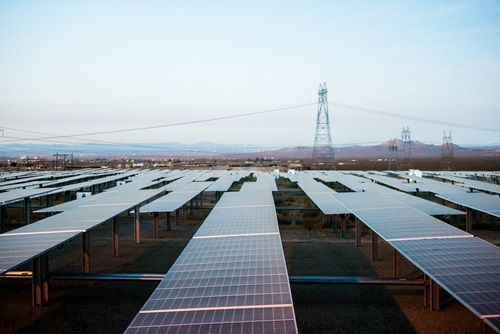
Solar panels produce energy at DWR’s Pearblossom Pumping Plant in Pearblossom, Calif. DWR/2018
Producing and Consuming Power
The State Water Project (SWP), operated by DWR, is both a major producer and consumer of electricity.
As the largest single consumer of electricity in California, the SWP pump load ranges from 6,000,000 megawatt hours (MWh) to 9,500,000 MWh depending on the type of water year (dry, average, wet). The electricity is used to operate the SWP pumping plants, which are needed to deliver the water throughout the State.
The SWP has one of the cleanest power portfolios of all major utilities in California. DWR has been proactively responding to the evolving power market by reducing reliance on fossil fuel energy resources, assisting in maintaining grid reliability, and controlling energy costs for water customers.
With 55 percent of the SWP’s power provided by its own carbon-free hydroelectric generation, the SWP is committed to reducing its carbon footprint by having a power portfolio consisting of 100 percent carbon-free resources by 2035. DWR is finding innovative ways, such as adding solar to the system, to make this happen.
Producer of Electricity
DWR also produces electricity, which ultimately helps meet SWP’s power demands. The energy produced—which is highly variable due to changes in annual hydrologic conditions—averages around 6 billion kilowatt-hours (kWh) a year.
As a producer of electricity, we are subject to regulation under the authority of the Federal Power Act. We have three hydropower licenses and two conduit exemptions under authority of the Federal Energy Regulatory Commission. To maintain these licenses, DWR must comply with the terms and conditions to protect, mitigate and enhance beneficial public uses of hydropower projects.
The SWP uses five hydroelectric generating plants and four hybrid pumping/generating plants to generate clean power. DWR sells the power it generates from the SWP to the California Independent System Operator (CAISO) market, during peak demand hours and help displace fossil generation and lower overall grid greenhouse gas (GHG) emissions. The revenue from these sales helps keep the net cost of water deliveries more affordable.
The SWP’s flexible pumping operations help it to manage the timing of its power needs. This flexibility is allowed by Project reservoirs, which temporarily store water until it is needed to meet the daily and seasonal demands of its contracting agencies.
To reduce power costs, pumping is minimized during on-peak hours when power prices are highest. Maximum pumping is scheduled during off-peak periods (nights, solar hours, weekends and holidays) when power costs are cheaper. Thus, the SWP can purchase, when needed, inexpensive surplus generation from other power suppliers for its pumping operations.
Buying Power
In addition to being a producer of power, DWR has a long history of purchasing power. In 2000 and 2001, the investor-owned utilities were in crisis. Pacific Gas and Electric (PG&E) filed for bankruptcy in 2001 and Southern California Edison (SCE) and San Diego Gas and Electric (SDG&E) were on the verge of bankruptcy, in large part due to skyrocketing energy prices. In response to the turn-of-the-millennium energy crisis, Governor Gray Davis signed an Executive Order in January 2001 that ordered DWR to purchase energy for California's three largest Investor-Owned Utilities (PG&E, SCE, SDG&E, collectively the “IOUs”) and in February 2001, Assembly Bill 1-X authorized the Department to secure and retain title to power for resale to end use customers in the IOUs' service territories.
DWR established the California Energy Resources Scheduling division (CERS) to buy and sell power on behalf of the IOUs’ retail customers. DWR retained the legal and financial responsibility for each contract while eventually, the IOUs performed the scheduling, dispatch, and other administrative functions for the long-term contracts, as agents for DWR.
CERS actions helped stabilize the wholesale power markets in California and returned electricity prices to reasonable levels. By 2015, the remaining power contracts ended. In 2020, the remaining bonds that were issued in 2002 were legally satisfied. The CERS program was renamed to the Electric Power Fund and the CERS division was renamed to the California Energy Bond Office. The Electric Power Fund program is continuing to wind down and is now focused on litigation related to the 2001 energy crisis and returning any litigation settlements and excess dollars to the IOUs’ retail customers.
